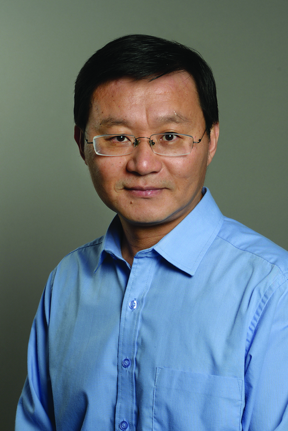Home > Press > An artificial material that can sense, adapt to its environment: University of Missouri engineers are collaborating with researchers at University of Chicago to design the material
 |
| Guoliang Huang is the Huber and Helen Croft Chair in Engineering at the University of Missouri College of Engineering.
CREDIT University of Missouri |
Abstract:
Move over, Hollywood science fiction is getting ready to leap off the big screen and enter the real world. While recent science fiction movies have demonstrated the power of artificially intelligent computer programs, such as the fictional character J.A.R.V.I.S. in the Avenger film series, to make independent decisions to carry out a set of actions, these imagined movie scenarios could now be closer to becoming a reality.
An artificial material that can sense, adapt to its environment: University of Missouri engineers are collaborating with researchers at University of Chicago to design the material
Columbia, MO | Posted on November 5th, 2021
In a recent study published in Nature Communications, a journal of Nature, researchers at the University of Missouri and University of Chicago have developed an artificial material, called a metamaterial, which can respond to its environment, independently make a decision, and perform an action not directed by a human being. For example, a drone making a delivery might evaluate its environment including wind direction, speed or wildlife, and automatically change course in order to complete the delivery safely.
Guoliang Huang, Huber and Helen Croft Chair in Engineering, and co-author on the study, said the mechanical design of their new artificial material incorporates three main functions also displayed by materials found in nature sensing; information processing; and actuation, or movement.
Some examples of these natural materials include the quick reaction of a Venus fly traps leafy jaws to capture an insect, chameleons changing the color of their skin to blend into their surroundings, and pine cones adjusting their shapes in response to changes in air humidity, Huang said.
Basically, we are controlling how this material responds to changes in external stimuli found in its surroundings, Huang said. For example, we can apply this material to stealth technology in the aerospace industry by attaching the material to aerospace structures. It can help control and decrease noises coming from the aircraft, such as engine vibrations, which can increase its multifunctional capabilities.
The material uses a computer chip to control or manipulate the processing of information thats needed to perform the requested actions, then uses the electrical power to convert that energy into mechanical energy. The researchers next step is to implement their idea in a real-world environment.
Realization of active metamaterials with odd micropolar elasticity, was published in Nature Communications. Co-authors include Yangyang Chen and Xiaopeng Li at MU and Colin Scheibner and Vincenzo Vitelli at the University of Chicago.
Funding is provided by grants from the Air Force Office of Scientific Research (AF9550-18-1-0342 and AF 9550-20-0279), the Army Research Office (W911NF-18-1-0031 and W911NF-19-1-0268) and the National Science Foundation Graduate Research Fellowship (1746045). The content is solely the responsibility of the authors and does not necessarily represent the official views of the funding agencies.
####
For more information, please click here
Contacts:
Eric Stann
University of Missouri-Columbia
Office: 573-882-3346
Copyright © University of Missouri-Columbia
If you have a comment, please Contact us.
Issuers of news releases, not 7th Wave, Inc. or Nanotechnology Now, are solely responsible for the accuracy of the content.
News and information
![]() Thin-film, high-frequency antenna array offers new flexibility for wireless communications November 5th, 2021
Thin-film, high-frequency antenna array offers new flexibility for wireless communications November 5th, 2021
![]() Reaction-dependent coffee-ring-regulating method in spray-coating perovskite November 5th, 2021
Reaction-dependent coffee-ring-regulating method in spray-coating perovskite November 5th, 2021
![]() Quantifying spin for future spintronics: Spin-momentum locking induced anisotropic magnetoresistance in monolayer WTe2 November 5th, 2021
Quantifying spin for future spintronics: Spin-momentum locking induced anisotropic magnetoresistance in monolayer WTe2 November 5th, 2021
![]() A new dimension in magnetism and superconductivity launched November 5th, 2021
A new dimension in magnetism and superconductivity launched November 5th, 2021
Govt.-Legislation/Regulation/Funding/Policy
![]() Thin-film, high-frequency antenna array offers new flexibility for wireless communications November 5th, 2021
Thin-film, high-frequency antenna array offers new flexibility for wireless communications November 5th, 2021
![]() Molecular Sciences Software Institute receives $15 million grant from National Science Foundation October 15th, 2021
Molecular Sciences Software Institute receives $15 million grant from National Science Foundation October 15th, 2021
![]() Scientists discover spin polarization induced by shear flow October 1st, 2021
Scientists discover spin polarization induced by shear flow October 1st, 2021
![]() UTA project aims to extend life of concrete, cement by adding nanoscale wood fibers: Wood fibers key to sustainable concrete, cement September 24th, 2021
UTA project aims to extend life of concrete, cement by adding nanoscale wood fibers: Wood fibers key to sustainable concrete, cement September 24th, 2021
Possible Futures
![]() Quantum Physics in Proteins: Artificial intelligence affords unprecedented insights into how biomolecules work November 5th, 2021
Quantum Physics in Proteins: Artificial intelligence affords unprecedented insights into how biomolecules work November 5th, 2021
![]() Securing data transfers with relativity: A team from UNIGE has implemented a new way to secure data transfers based on the physical principle of relativity November 5th, 2021
Securing data transfers with relativity: A team from UNIGE has implemented a new way to secure data transfers based on the physical principle of relativity November 5th, 2021
![]() Color-changing indicator predicts algal blooms November 5th, 2021
Color-changing indicator predicts algal blooms November 5th, 2021
![]() Thin-film, high-frequency antenna array offers new flexibility for wireless communications November 5th, 2021
Thin-film, high-frequency antenna array offers new flexibility for wireless communications November 5th, 2021
Discoveries
![]() Securing data transfers with relativity: A team from UNIGE has implemented a new way to secure data transfers based on the physical principle of relativity November 5th, 2021
Securing data transfers with relativity: A team from UNIGE has implemented a new way to secure data transfers based on the physical principle of relativity November 5th, 2021
![]() Color-changing indicator predicts algal blooms November 5th, 2021
Color-changing indicator predicts algal blooms November 5th, 2021
![]() Thin-film, high-frequency antenna array offers new flexibility for wireless communications November 5th, 2021
Thin-film, high-frequency antenna array offers new flexibility for wireless communications November 5th, 2021
![]() Reaction-dependent coffee-ring-regulating method in spray-coating perovskite November 5th, 2021
Reaction-dependent coffee-ring-regulating method in spray-coating perovskite November 5th, 2021
Materials/Metamaterials
![]() UTA project aims to extend life of concrete, cement by adding nanoscale wood fibers: Wood fibers key to sustainable concrete, cement September 24th, 2021
UTA project aims to extend life of concrete, cement by adding nanoscale wood fibers: Wood fibers key to sustainable concrete, cement September 24th, 2021
![]() Nanocellulose decorated with proteins is suitable for 3D cell culturing September 24th, 2021
Nanocellulose decorated with proteins is suitable for 3D cell culturing September 24th, 2021
![]() Scientists demonstrate pathway to forerunner of nanotubes that could lead to widespread industrial fabrication September 17th, 2021
Scientists demonstrate pathway to forerunner of nanotubes that could lead to widespread industrial fabrication September 17th, 2021
![]() New substance classes for nanomaterials: Nano spheres and diamond slivers made of silicon and germanium: Potential applications as nano semiconductor materials September 10th, 2021
New substance classes for nanomaterials: Nano spheres and diamond slivers made of silicon and germanium: Potential applications as nano semiconductor materials September 10th, 2021
Announcements
![]() Thin-film, high-frequency antenna array offers new flexibility for wireless communications November 5th, 2021
Thin-film, high-frequency antenna array offers new flexibility for wireless communications November 5th, 2021
![]() Reaction-dependent coffee-ring-regulating method in spray-coating perovskite November 5th, 2021
Reaction-dependent coffee-ring-regulating method in spray-coating perovskite November 5th, 2021
![]() Quantifying spin for future spintronics: Spin-momentum locking induced anisotropic magnetoresistance in monolayer WTe2 November 5th, 2021
Quantifying spin for future spintronics: Spin-momentum locking induced anisotropic magnetoresistance in monolayer WTe2 November 5th, 2021
![]() A new dimension in magnetism and superconductivity launched November 5th, 2021
A new dimension in magnetism and superconductivity launched November 5th, 2021
Interviews/Book Reviews/Essays/Reports/Podcasts/Journals/White papers/Posters
![]() Quantum Physics in Proteins: Artificial intelligence affords unprecedented insights into how biomolecules work November 5th, 2021
Quantum Physics in Proteins: Artificial intelligence affords unprecedented insights into how biomolecules work November 5th, 2021
![]() Securing data transfers with relativity: A team from UNIGE has implemented a new way to secure data transfers based on the physical principle of relativity November 5th, 2021
Securing data transfers with relativity: A team from UNIGE has implemented a new way to secure data transfers based on the physical principle of relativity November 5th, 2021
![]() Quantifying spin for future spintronics: Spin-momentum locking induced anisotropic magnetoresistance in monolayer WTe2 November 5th, 2021
Quantifying spin for future spintronics: Spin-momentum locking induced anisotropic magnetoresistance in monolayer WTe2 November 5th, 2021
![]() A new dimension in magnetism and superconductivity launched November 5th, 2021
A new dimension in magnetism and superconductivity launched November 5th, 2021
Military
![]() Thin-film, high-frequency antenna array offers new flexibility for wireless communications November 5th, 2021
Thin-film, high-frequency antenna array offers new flexibility for wireless communications November 5th, 2021
![]() Scientists demonstrate pathway to forerunner of nanotubes that could lead to widespread industrial fabrication September 17th, 2021
Scientists demonstrate pathway to forerunner of nanotubes that could lead to widespread industrial fabrication September 17th, 2021
![]() Putting a new theory of many-particle quantum systems to the test: Experiments show that generalized hydrodynamics accurately simulates an out-of-equilibrium quantum system September 3rd, 2021
Putting a new theory of many-particle quantum systems to the test: Experiments show that generalized hydrodynamics accurately simulates an out-of-equilibrium quantum system September 3rd, 2021
![]() NISTs quantum crystal could be a new dark matter sensor Peer-Reviewed Publication August 6th, 2021
NISTs quantum crystal could be a new dark matter sensor Peer-Reviewed Publication August 6th, 2021










